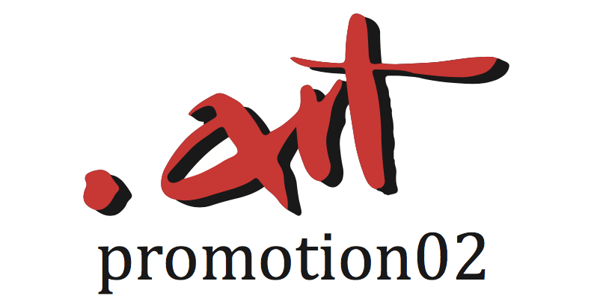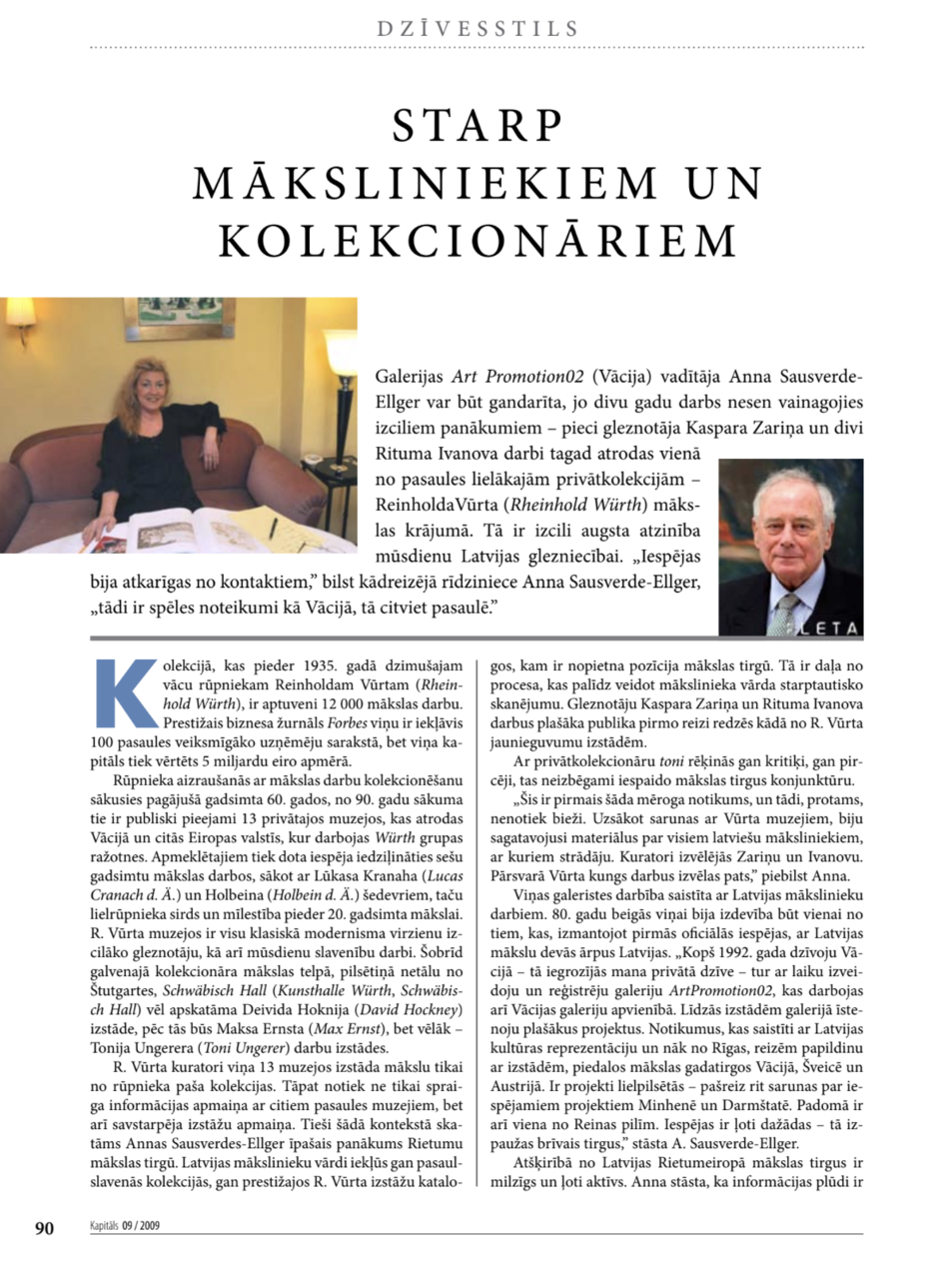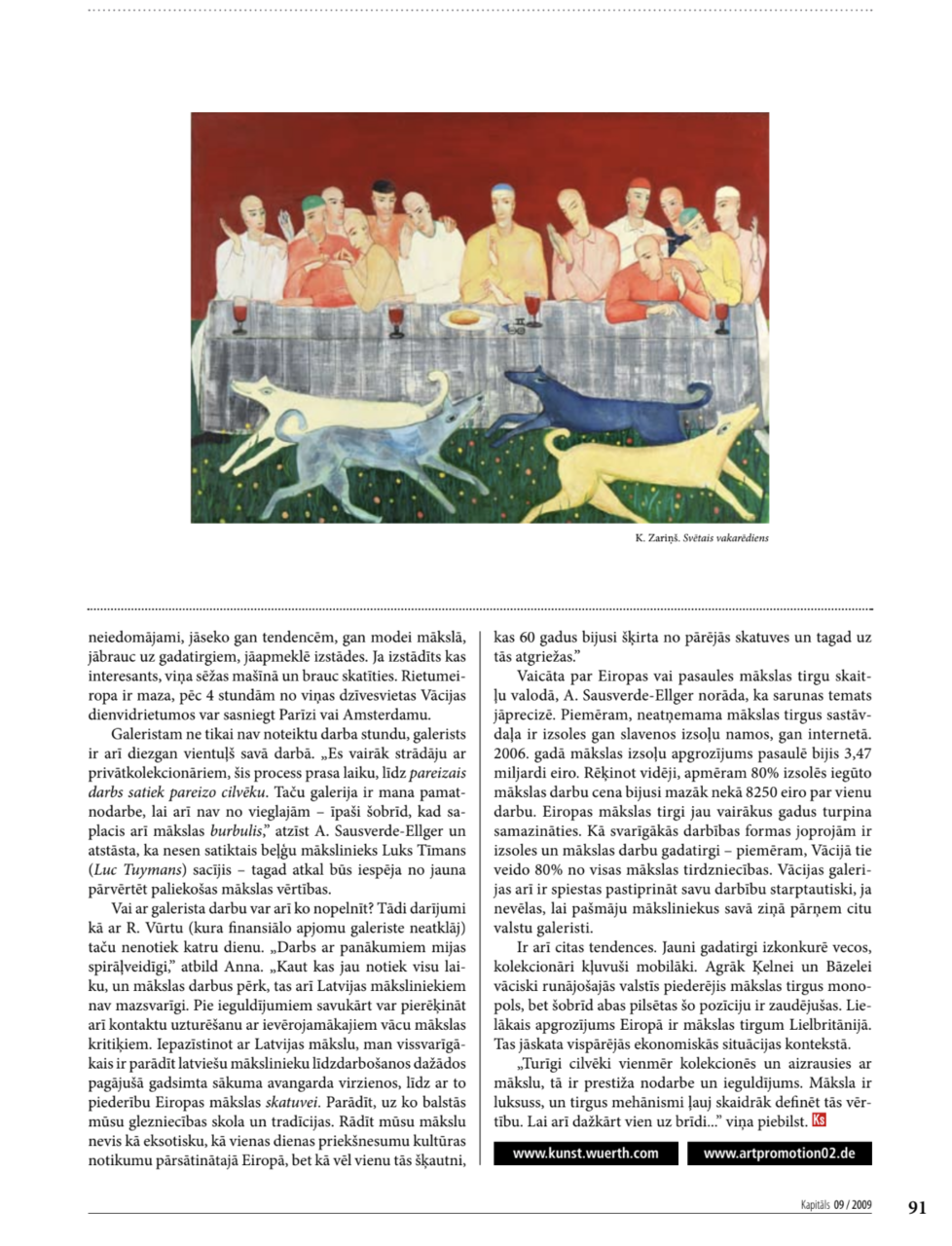Between Artists & Collectors
Article in Capital Magazine 09/2009. Anna Sausverde-Ellger, Head of Gallery Art Promotion02 (Germany) can be pleased because two years of work have crowned outstanding achievements: five works by painter Kaspars Zarins and two by Ritums Ivanovs now belong to one of the world's largest private collections: the one of Reinhold Würth. This is a very high recognition for contemporary Latvian painting. "Possibilities depended on contacts, ” says Anna Sausverde-Ellger. "These are the rules of the game in Germany and as well as elsewhere in the world."
The collection, which was established in 1935 by the German industrialist Reinhold Würth, has about 12,000 works of art. Prestigious business magazine Forbes has included him among 100 of the world's most successful entrepreneurs, his value is estimated at € 5 billion.
The industrialist's passion for collecting works of art began in the 1960s, and since beginning of the 1990s they are publicly available in 13 private museums located at Germany and other European countries where Würth groups operate factories. Visitors are given the opportunity to see six centuries of artwork, beginning with Cranach and Holbein masterpieces. However, the heart and love of the collector belongs to the art of the 20th century.
The Würth museums have all the classical trends of modernism, the most famous painters, as well as works of contemporary celebrities. Currently, the main art space of the collector aka Kunsthalle Würth, Schwabisch Hall is showing David Hockney followed by Max Ernst, and later on Toni Ungerer.
In his 13 private museums, the curators of Würth only exhibit art from the collection.
Exchange information and exchange of exhibitions takes place with other world museums. The success of Anna Sausverde-Ellger can be viewed exactly in this context of Western art market. The names of Latvian artists enter the world famous collections, and prestigious exhibition catalogues of the art market. It's the part of the process that helps to support the names of artists on the international scene.
The tone of private collectors is taken into account both by critics and this inevitably affects the art market.
"This is the first event of this size and of course these not happen often. When I started talks with the Würth museums, I had prepared materials about all Latvian artists who work with. The curators chose Zarins and Ivanovs. Mostly Mr. Würth chooses his works himself, ”adds Anna.
Her work as a gallerist is connected with Latvian artists. In the late 1980s she had the chance to be one those who could use the first official opportunities when Latvian art headed outside Latvia. “Since 1992 I have been living in Germany due to my own private life so with time I created and registered ArtPromotion02 gallery, which works also in the German gallery association. In addition to exhibitions in the gallery, I also execute projects and events related to Latvian representation of culture. Sometimes I supplement exhibitions with participation in art fairs in Germany, Switzerland and Austria. There are ongoing talks about projects in Munich and Darmstadt. The possibilities are very different, this is the free market, ”says A. Sausverde-Ellger.
Unlike that of Latvia, the art market of Western Europe is huge and very active. Anna says the flood of information is unimaginable, one needs to follow trends both in fashion and art, go to fairs, visit exhibitions. If something exciting gets exhibited, she sits into her car and drives there to see it. Western Europe is small and in 4 hours one can reach Paris or Amsterdam.
The gallerist does not have strict working hour and is also quite lonely in her work. "I work more with private collectors, this process takes time until the right one meets the right person. But the gallery is my basic activity, although it is not easy - especially now that also the art bubble has broken, ”admits A. Sausverde-Ellger and remarks that the Belgian artist Luc Tuymans who she recently met, said - this is now an opportunity to reevaluate permanent art values again.
What are the earnings of the gallerist's job? The gallerist does not disclose the financial size of transactions like with R. Wurth. "Working with success has a spiral structure, ”says Anna. “Something is happening all the time and artworks are bought by Latvian artists, which is important. Maintaining contacts with the most notable German art critics can also be considered an investment. When introducing Latvian art, it is important to show the participation of Latvian artists in the avant-garde movements of the beginning of the last century, hence belonging to the European art scene. It needs to be shown, what are
our painting school and traditions based on. To show our art not as an exotic one-day thing in an over-saturated Europe, but the edge of it that has been gone for 60 years and is now returning.
When asked about the numbers of the European or world art markets, A. Sausverde-Ellger points out that the subject of the conversation should be clarified. For example, an integral part of the art market is formed by auctions in both famous auction houses as well as the internet. In 2006, world art auction turnover was 3.47 EUR billion. Approximately 80% of cases (on average), the price of works was less than 8250 euros per
work. European art markets have been declining for several years now. The most important forms of activity are still auctions and art fairs, for example, in Germany 80% of all art trade is made up by the named. German galleries have also been forced to step up their activities internationally.
There are also other prevalent trends. New fairs compete with old ones and collectors have become more mobile.The former monopolies of Cologne and Basel have lost their positions. The biggest turnover in Europe is owned by art market of the UK. This however should be seen in the context of the overall economic situation.
"The wealthy will always collect and look for art, this is prestigious activity and investment. Art is luxury, and market mechanisms allow a clearer definition of this.” Sausverde adds.
More: Capital Magazine
The industrialist's passion for collecting works of art began in the 1960s, and since beginning of the 1990s they are publicly available in 13 private museums located at Germany and other European countries where Würth groups operate factories. Visitors are given the opportunity to see six centuries of artwork, beginning with Cranach and Holbein masterpieces. However, the heart and love of the collector belongs to the art of the 20th century.
The Würth museums have all the classical trends of modernism, the most famous painters, as well as works of contemporary celebrities. Currently, the main art space of the collector aka Kunsthalle Würth, Schwabisch Hall is showing David Hockney followed by Max Ernst, and later on Toni Ungerer.
In his 13 private museums, the curators of Würth only exhibit art from the collection.
Exchange information and exchange of exhibitions takes place with other world museums. The success of Anna Sausverde-Ellger can be viewed exactly in this context of Western art market. The names of Latvian artists enter the world famous collections, and prestigious exhibition catalogues of the art market. It's the part of the process that helps to support the names of artists on the international scene.
The tone of private collectors is taken into account both by critics and this inevitably affects the art market.
"This is the first event of this size and of course these not happen often. When I started talks with the Würth museums, I had prepared materials about all Latvian artists who work with. The curators chose Zarins and Ivanovs. Mostly Mr. Würth chooses his works himself, ”adds Anna.
Her work as a gallerist is connected with Latvian artists. In the late 1980s she had the chance to be one those who could use the first official opportunities when Latvian art headed outside Latvia. “Since 1992 I have been living in Germany due to my own private life so with time I created and registered ArtPromotion02 gallery, which works also in the German gallery association. In addition to exhibitions in the gallery, I also execute projects and events related to Latvian representation of culture. Sometimes I supplement exhibitions with participation in art fairs in Germany, Switzerland and Austria. There are ongoing talks about projects in Munich and Darmstadt. The possibilities are very different, this is the free market, ”says A. Sausverde-Ellger.
Unlike that of Latvia, the art market of Western Europe is huge and very active. Anna says the flood of information is unimaginable, one needs to follow trends both in fashion and art, go to fairs, visit exhibitions. If something exciting gets exhibited, she sits into her car and drives there to see it. Western Europe is small and in 4 hours one can reach Paris or Amsterdam.
The gallerist does not have strict working hour and is also quite lonely in her work. "I work more with private collectors, this process takes time until the right one meets the right person. But the gallery is my basic activity, although it is not easy - especially now that also the art bubble has broken, ”admits A. Sausverde-Ellger and remarks that the Belgian artist Luc Tuymans who she recently met, said - this is now an opportunity to reevaluate permanent art values again.
What are the earnings of the gallerist's job? The gallerist does not disclose the financial size of transactions like with R. Wurth. "Working with success has a spiral structure, ”says Anna. “Something is happening all the time and artworks are bought by Latvian artists, which is important. Maintaining contacts with the most notable German art critics can also be considered an investment. When introducing Latvian art, it is important to show the participation of Latvian artists in the avant-garde movements of the beginning of the last century, hence belonging to the European art scene. It needs to be shown, what are
our painting school and traditions based on. To show our art not as an exotic one-day thing in an over-saturated Europe, but the edge of it that has been gone for 60 years and is now returning.
When asked about the numbers of the European or world art markets, A. Sausverde-Ellger points out that the subject of the conversation should be clarified. For example, an integral part of the art market is formed by auctions in both famous auction houses as well as the internet. In 2006, world art auction turnover was 3.47 EUR billion. Approximately 80% of cases (on average), the price of works was less than 8250 euros per
work. European art markets have been declining for several years now. The most important forms of activity are still auctions and art fairs, for example, in Germany 80% of all art trade is made up by the named. German galleries have also been forced to step up their activities internationally.
There are also other prevalent trends. New fairs compete with old ones and collectors have become more mobile.The former monopolies of Cologne and Basel have lost their positions. The biggest turnover in Europe is owned by art market of the UK. This however should be seen in the context of the overall economic situation.
"The wealthy will always collect and look for art, this is prestigious activity and investment. Art is luxury, and market mechanisms allow a clearer definition of this.” Sausverde adds.
More: Capital Magazine



No replies